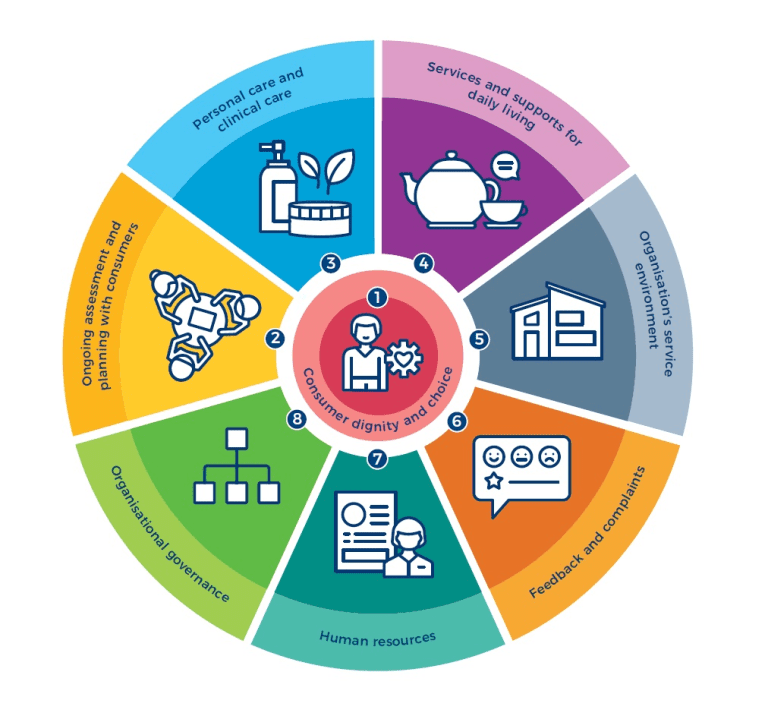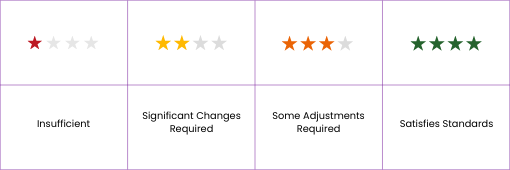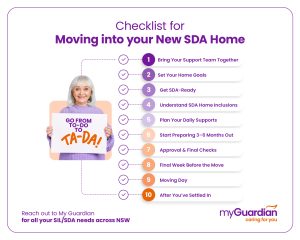As you get older, it can be frustrating when the care you receive isn’t as personal or respectful as it should be. You may wonder whether your support truly meets your needs or if you’re just another number in the system.
This is where the Aged Care Quality Standards come in. These standards set the benchmark for safe, personalised, and high-quality care, ensuring that providers deliver support with dignity, respect, and a focus on your individual preferences.
When choosing an aged care provider, make sure they meet the eight Aged Care Quality Standards. In this article, we’ll outline what these standards are, how they improve care services, and what to look for to ensure your provider upholds these essential benchmarks.
The 8 Aged Care Quality Standards
The Aged Care Quality Standards are a set of rules and regulations designed to ensure that older Australians receive safe, high-quality care and services. These standards are intended to guarantee that aged care providers meet the criteria required to deliver care that is respectful, person-centred, and tailored to the needs and preferences of the individual.
Additionally, they help make it easier to compare the performance of different aged care providers, ensuring you find the best care for your needs.
- Standard 1: Consumer Dignity and Choice
- Standard 2: Ongoing Assessment and Planning
- Standard 3: Personal Care and Clinical Care
- Standard 4: Service and Support for Daily Life
- Standard 5: Organisation’s Service Environment
- Standard 6: Feedback and Compliant
- Standard 7: Human Resource
- Standard 8: Organisational Governance
The Aged Care Quality Standards are rules and regulations that ensure older Australians receive safe, high-quality care and services.

Standard 1: Consumer Dignity and Choice
The first standard emphasises the importance of treating consumers with dignity and respect. Aged care services must recognise the individuality of each resident, allowing them to make choices about their care and lifestyle. This includes respecting their cultural, spiritual, and personal preferences. By promoting dignity and choice, aged care providers empower residents to maintain their identity and autonomy, which is crucial for their overall well-being.
Standard 1 underpins all other Aged Care Quality Standards, ensuring a consumer-centred approach to care.
What it means to you: You are treated with dignity and respect, can maintain your identity, make informed choices about your care, and live the life you choose.
Key Principles:
- Dignity & Respect: Recognising strengths, fostering independence, and valuing individuality in care and communication.
- Identity, Culture & Diversity: Inclusive, non-discriminatory care that respects cultural, linguistic, and personal identities.
- Cultural Safety: Consumers define cultural safety; providers must acknowledge and respect cultural differences.
- Choice & Independence: Consumers have the right to make informed decisions, access support, and receive services that align with their preferences.
- Dignity of Risk: Balancing safety with personal choice, supporting informed risk-taking while managing health and safety responsibilities.
- Information Accessibility: Providing timely, understandable, and accessible information tailored to individual needs.
- Privacy: Protecting personal information and ensuring private, respectful interactions.
Standard 2: Ongoing Assessment and Planning
This standard focuses on the need for continuous assessment and planning of care. Aged care providers are required to regularly evaluate the needs and preferences of each resident. This ongoing assessment ensures that care plans are tailored to meet the evolving needs of individuals, allowing for timely adjustments as circumstances change. By prioritising personalised care, providers can enhance the quality of life for residents.
What it means to you: You are a partner in ongoing assessment and planning to ensure you receive the care and services needed for your health and well-being.
Purpose and Scope of the Standard
Building on Standard 1, this standard ensures that organisations work with you to plan care and services that match your needs, goals, and preferences. Even if you face health challenges, you still have personal goals and aspirations, and your care should support your independence and well-being.
Organisations must listen to you, recognise your abilities, and plan services that help you maintain your daily life. Care plans should be reviewed regularly to adapt to changes in your health. The level of planning depends on the type of care provided, from basic home services to full residential care.
Standard 3: Personal Care and Clinical Care
Personal and clinical care is at the heart of aged care services. This standard mandates that providers deliver safe and effective care that meets the physical, emotional, and psychological needs of residents.
This includes assistance with daily living activities, medication management, and access to healthcare professionals when needed. By adhering to this standard, aged care services can ensure that residents receive comprehensive care that promotes their health and well-being.
What it means to you: You receive personal and clinical care that is safe, appropriate, and tailored to your needs.
Purpose and Scope of the Standard
Consumers expect safe, effective, and high-quality personal and clinical care. This standard applies to all aged care providers delivering these services under the Quality of Care Principles 2014. Personal and clinical care may include:
- Assistance with bathing, dressing, and personal hygiene.
- Mobility aids and communication support for hearing, speech, or vision impairments.
- Nursing services, such as wound management and catheter care.
- Therapy services to improve independence and daily living.
- Support for individuals with cognitive impairments.
While many aged care providers deliver quality care, some consumers still experience preventable harm. This standard emphasises proactive measures to reduce risks, particularly in infection prevention and outbreak management, ensuring consumers receive safe and high-quality care.
This guidance does not provide clinical instructions but requires organisations to develop and implement policies that align with best practices. Providers must ensure their workforce is trained to deliver care safely and effectively.
Standard 4: Services and Supports for Daily Living
Aged care is not just about medical care; it also encompasses support for daily living activities. This standard requires providers to offer services that help residents maintain their independence and quality of life.
This can include assistance with meal preparation, housekeeping, transportation, and social activities. By providing these essential services, aged care providers can help residents lead fulfilling lives while receiving the support they need.
What it means to you: You receive the services and support for daily living that are essential for your health and well-being, allowing you to do the things you want to do.
Key Requirements
Standard 4 emphasises the following key requirements:
- Consumer-Centric Services: Services should be safe and efficient, focusing on meeting the individual needs, preferences, and goals of consumers, while promoting their independence and overall well-being.
- Holistic Support: Daily living services must contribute to enhancing the emotional, spiritual, and psychological health of consumers.
- Encouraging Engagement: Support services should foster consumer participation in community activities, strengthen social and personal relationships, and help consumers engage in interests and hobbies.
- Collaboration with Carers: It is essential to keep other carers informed about the consumer’s health condition, needs, and preferences for effective care coordination.
- Nutritious Meals: Services should ensure the provision of nutritious and varied meals that meet the consumer’s dietary needs.
- Safe Equipment: All equipment should be safe, suitable for use, and regularly maintained to ensure it is clean and in good condition.
We are here to help.
Request a call back to get your free consultation and ongoing support.
Standard 5: Organisation’s Service Environment
Standard 5 specifically applies to the physical service environment in residential care, respite care, and day therapy centres. It does not apply to home care services or other public spaces like libraries or bowling clubs. This Standard ensures the physical environment of the service supports the consumer’s quality of life and independence. It should be clean, comfortable, welcoming, and well-maintained.
What it means to you: You feel a sense of belonging and are safe and comfortable in the organisation’s service environment.
Key Elements of This Standard
The service environment should:
- Supports the consumer’s ability to participate in community activities and interact with others.
- Minimises confusion, helping consumers recognise where they are and find their way.
- Encourages consumers to personalise their living areas.
- Welcomes consumers and their families, providing areas for culturally sensitive interactions.
- The environment should always be safe, clean, and well-maintained.
- Ensures that consumers can move freely within the environment, including outdoor areas.
- Safety features should be present, but not overpower the environment.
- Implements appropriate security measures to protect consumers when necessary.
- The service’s furniture, fittings, and equipment should be safe, clean, well-maintained, and appropriate for the consumer’s needs.
Standard 6: Feedback and Complaints
Open communication is vital in any care setting. This standard emphasises the importance of feedback and complaints mechanisms within aged care services. Providers must create an environment where residents feel comfortable voicing their concerns and suggestions. By actively seeking feedback and addressing complaints, aged care services can continuously improve their practices and ensure that residents feel heard and valued.
What it means to you: You feel safe and are encouraged and supported to provide feedback and make complaints. You are involved in the processes to address your feedback and complaints, and appropriate actions are taken.
Key Elements
- Encouraging Feedback: Consumers are encouraged to give both positive and negative feedback about the care and services they receive.
- Responding to Complaints: The organisation should respond to both formal and informal complaints, whether made in writing or verbally.
- Continuous Improvement: Feedback and complaints should be used to inform improvements in care and services.
Resolving Issues: The organisation works to resolve issues for consumers and others.
Standard 7: Human Resources
The quality of care in aged care facilities largely depends on the staff. This standard focuses on the recruitment, training, and ongoing development of personnel. Aged care providers must ensure that their staff members are qualified, skilled, and adequately trained to deliver high-quality care. This includes providing opportunities for professional development and fostering a positive workplace culture. By investing in their workforce, aged care services can enhance the quality of care provided to residents.
What it means to you: You receive quality care and services when needed, provided by knowledgeable, capable, and caring individuals.
Key concepts of this Standard include
- Sufficient Workforce: Organisations must have enough qualified staff to meet consumers’ needs. This includes using funding to hire the right number and type of staff, including specific roles like infection control leads.
- Workforce Skills and Attitude: Staff need to have the right skills and knowledge, be able to do their jobs well, and build positive relationships with consumers. The focus should be on consumer-centred care.
- Support for the Workforce: The organisation must respect and support its staff by providing the tools, time, and resources they need to deliver quality care. This includes training, especially in areas like infection control.
- Assessment and Review: The organisation must regularly review its staff to ensure they are suitable and performing well, to continue delivering safe and quality care that meets consumers’ needs.
Standard 8: Organisational Governance
Effective governance is essential for the successful operation of aged care services. This standard requires providers to have clear policies and procedures in place to ensure compliance with regulations and standards. Strong governance structures help maintain accountability, transparency, and ethical practices within aged care organisations. By prioritising good governance, providers can build trust with residents and their families, ensuring that care is delivered consistently and responsibly.
What it means to you: You receive quality care and services when needed, provided by knowledgeable, capable, and caring individuals.
Key Elements of the Standard
- Governing Body Accountability: The governing body is responsible for ensuring the delivery of safe, high-quality care and services that meet the Standards.
- Focus on Consumer Safety and Quality: The governing body promotes a culture of safety and quality, monitoring improvements and ensuring that the best interests of consumers are prioritised.
- Risk Management and Emergency Planning: Organisations must plan for emergencies, manage high-risk care areas, and ensure proper infection prevention and control procedures.
- Key Areas of Focus: The governing body must address high-impact risks, abuse and neglect, antimicrobial stewardship, minimising restraint use, and practising open disclosure.
- Governance System Structure: The governance structure should align with the organisation’s size, setting, and the nature of care provided, ensuring effective assessment, monitoring, and continuous improvement.
Who Monitors the Aged Care Quality Standard?
The Aged Care Quality and Safety Commission is responsible for monitoring the Aged Care Quality Standards in Australia. This independent agency oversees and ensures that aged care services are meeting the required standards. Their role includes:
- Assessing Providers: The Commission conducts audits and inspections of aged care services to evaluate compliance with the standards.
- Receiving Complaints: It also manages complaints related to aged care services, ensuring concerns are addressed appropriately.
- Improvement Actions: The Commission supports aged care providers in improving their practices when they fail to meet the standards and holds them accountable for compliance.
- Reporting: It monitors the quality of care across the sector and provides public reports and information on service provider performance.
The Aged Care Quality Standards are evaluated using a four-bar rating system to determine a facility’s compliance. Here’s what each bar represents:

Conclusion
The eight Standards of Aged Care ensure that older individuals receive the care and assistance they deserve, with an emphasis on dignity, personalised care, and continual improvement. Assessed by the Aged Care Quality and Safety Commission, it is critical to select an elderly care home that meets the requirement for safety, respect, and high-quality service.
At My Guardian, we are committed to making sure you or your loved ones receive the best possible care, tailored to individual needs and preferences. If you’re looking for aged care services that prioritise dignity, safety, and well-being, get in touch with us today to find out how we can support you.






